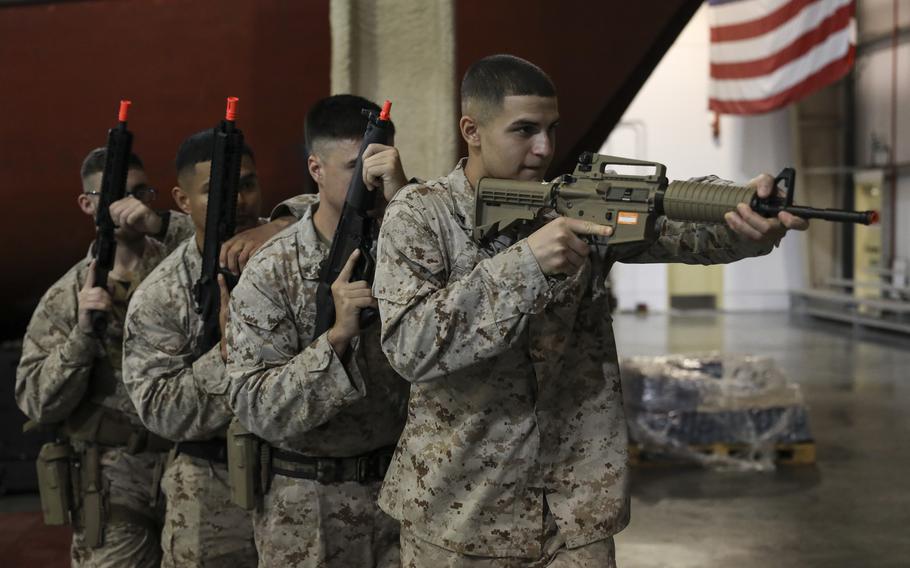
U.S. Marines assigned to Fleet Anti-terrorism Security Team Company Central stack up during close-quarters training in Bahrain, July 03, 2023. Marines in Bahrain also are training for potential shipboard roles protecting oil tankers and other commercial ships from Iranian aggression, a U.S. official said. (Angela Wilcox/U.S. Marine Corps)
In a timely return to their roots, U.S. Marines are training in the Middle East and preparing to embark on civilian merchant ships to protect them from Iran’s increasingly predatory behavior.
These specialized Marine units, known as Fleet Anti-terrorism Security Teams, or FASTs, have been deployed in response to over 20 incidents of Iranian Revolutionary Guard maritime forces harassing, firing on, boarding and seizing legitimate merchant traffic in the Arabian Gulf over the past two years. On July 5, Iranian forces opened fire on two tankers in international waters before U.S. forces intervened.
According to news reports, over 100 Marines and sailors are training in Bahrain, host to the U.S. 5th Fleet, which oversees all maritime operations throughout the Middle East. While the operation doesn’t have final approval, it could roll out this month.
What does this plan tell us about U.S. intentions in the region, and how will the Iranians likely respond? First, it is important to remember that the original role of marines going back centuries was to be a powerful fighting force on sailing ships, often protecting convoys of commercial craft. For centuries, the British Royal Navy valued the marines embarked on massive sailing ships, who fought shoulder to shoulder with those sailors manning the big guns to repel boarders and rain down sniper fire from the masts.
Marines can be very lethal in these roles. For example, the most renowned admiral in history, Horatio Nelson, victor of the epic battle of Trafalgar, was himself shot down at the height of the battle by a marine sniper on a French warship. When I was a young engineer on the carrier USS Forrestal in the Mediterranean in early 1980s, we had a detachment of about 50 Marines on board — commanded by Capt. John Kelly, who probably put his combat skills to use decades later as chief of staff in the White House.
Despite the historical roots of the potential Gulf mission, using an embarked Marine detachment on civilian ships is not common these days, and doing so requires refining and developing operational protocols. The units will likely be offered to the merchant ships, not required, with priority probably given to U.S.-owned and flagged civilian vessels first. Next might come foreign ships with significant numbers of U.S. crew, and to those with cargoes coming to or departing U.S. waters.
The FAST squads would be outfitted with small arms, rocket-propelled grenades, and .50-caliber machine guns. Depending on the threat level, they could also be equipped with shoulder-fired surface-to-air missiles (such as Stingers) and drones to provide surface surveillance.
Most importantly, they would have jam-proof communications to ensure they could contact the 5th Fleet instantly and guide combat aircraft to attack Iranian surface vessels.
In addition to the small group training in Bahrain, a full amphibious readiness group (typically three major warships) recently arrived in the region, centered on the large-deck carrier USS Bataan. It has over 3,000 Marines and sailors and dozens of helicopters (many with significant combat capability). Guided-missile destroyers already stationed in the region will provide escort.
Backing up all the seagoing firepower are new combat aircraft to supplement the current Gulf deployment. These include an additional squadron of fifth-generation fighters, the F-35 Lightning II, and a pair of squadrons of F-16s, which are older but still highly capable aircraft. Venerable A-10 “Warthogs” are also deployed and bring a powerful air-to-surface punch.
There are plenty of risks in taking this aggressive but necessary stance. A decade ago, when I was the military commander of NATO, we tried similar methods using both marines and civilian security forces in counterpiracy operations. Unfortunately, we had several instances of significant “collateral damage” to fishing vessels and small civilian craft in the area. Two Italian marines mistakenly shot at an Indian fishing vessel in 2012, killing two fisherman, and were prosecuted for years until India’s supreme court dropped the charges.
The risk of quick escalation in the Gulf is ever present — just as in South China Sea, where American and Chinese ships have had regular faceoffs. U.S. Marines are well-trained, but they are young warriors, not seasoned diplomats. If the mission goes ahead, they will be aggressive in defending the civilian ships entrusted to them, and Iran could easily miscalculate U.S. resolve and find itself on the receiving end of missiles and bombs.
Yet the alternative — continuing to sanction the Iranians, scold them diplomatically and hope their behavior improves — won’t work. Almost 30% of the world’s oil comes through the Strait of Hormuz, and allowing Iran to control the Gulf and that vital chokepoint is unacceptable. Putting U.S. Marines “on deck” of vulnerable civilian merchant ships makes sense, and shows Iran we are deadly serious about freedom of the seas.
James Stavridis is a Bloomberg Opinion columnist. A retired U.S. Navy admiral, former supreme allied commander of NATO, and dean emeritus of the Fletcher School of Law and Diplomacy at Tufts University, he is vice chairman of global affairs at the Carlyle Group. He is on the boards of American Water Works, Fortinet, PreVeil, NFP, Ankura Consulting Group, Titan Holdings, Michael Baker and Neuberger Berman, and has advised Shield Capital, a firm that invests in the cybersecurity sector. This column does not necessarily reflect the opinion of the editorial board or Bloomberg LP and its owners